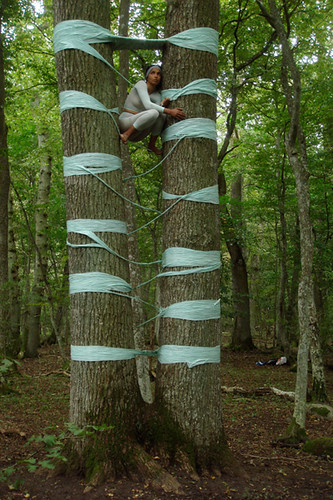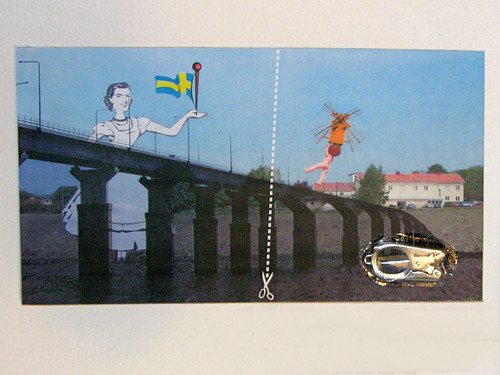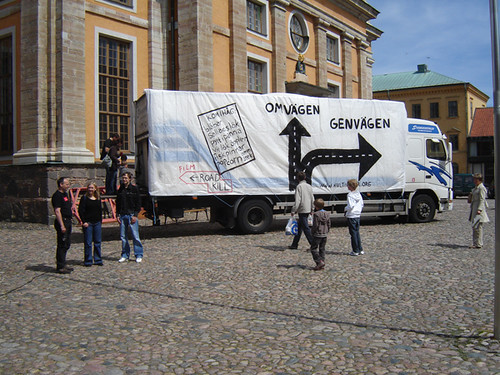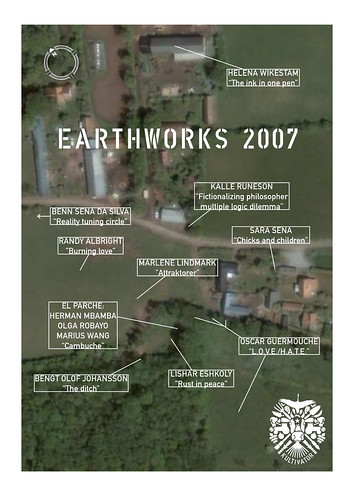

Exhibition in
W139, Amsterdam 'Das Bild muß die funktion der Kartoffel übernehmen ' Jörg Immendorf On December 2005 my family and I moved from Haarlem to a newly-built estate in the country to the north of Nijmegen. Five days later W139 called to ask if I was interested in applying for the post of director. I spent a couple of sleepless nights trying to let the strange concurrence of events sink in, and considered the transition from artist to curator. I realised that the change of roles would mean I d have to take a stance on the social role of the visual arts. And one of the things that popped into my mind in the middle of the night was that a meeting of the minds between artists and farmers could be more important than the present one-sided flirtation of art and philosophy. This inspiration was born out of a healthy aversion to the wish-washy talk about the post-agrarian and post-industrial society . The ideology of the knowledge economy is tacitly based on a geographic distribution between lords and servants. Because the knowledge worker still needs to feed, clothe and warm himself with agrarian and industrial products. In the meantime, in the visual arts, the post-productional artist has emerged and, while his roots are in left-wing philosophy rather than neoliberal thinking, his disparagement of material production is the same. Critical faculties have become more important than creative ones. KULTIVATOR is a collective of artists and farmers. On the island Öland just off the south coast of Sweden, the three Lindmark sisters and their spouses and children cultivate organic food, and host a residency programme and an international artists practice. In their first major retrospective in W139, potatoes and linseed oil, paintings and sculptures, sheepskins and films will be on show and on sale. The children of KULTIVATOR will live in a village of polyester igloos in the rear space of W139 and offer to trade their toys, comics and computer games. El Parche was invited to build an installation for the exhibition. The artists collective El Parche creates meeting places were they address political and cultural issues. Graphic designer Floor Wesseling, who designed the wonderful KULTIVATOR logo, will make a paste-up about the agrarian history of the Bijlmer. SUPERMODEL on Friday 12 October 9 p.m. will be opened by SUPERMACHINE; a procession of agricultural vehicles through the heart of Amsterdam. Gijs Frieling. Members of Kultivator: Malin Lindmark Vrijman, Kalle Runeson, Mathieu Vrijman, Marlene Lindmark, Henric Stigeborn en Mia Lindmark El Parche is a group of artists which includes: Herman Mbamba, Olga Robayo, Marius Wang Thanks to: City of Amsterdam, Ministry of OCW, VSBfonds, SolarOil systems, Agripom, Loonbedrijf K.J. Tromp, Office for Contemporary Art Norway During the exhibition there will be shown a Molkwerum-cabinet from the collectiion of the Zuiderzeemuseum in Enkhuizen.
slides
Supermachine films
sheepfilm
Exhibition in W139, Amsterdam
‘Das Bild muß die funktion der Kartoffel übernehmen ‘
Jörg Immendorf
On December 2005 my family and I moved from Haarlem to a newly-built estate in the country to the north of Nijmegen. Five days later W139 called to ask if I was interested in applying for the post of director. I spent a couple of sleepless nights trying to let the strange concurrence of events sink in, and considered the transition from artist to curator. I realised that the change of roles would mean I d have to take a stance on the social role of the visual arts. And one of the things that popped into my mind in the middle of the night was that a meeting of the minds between artists and farmers could be more important than the present one-sided flirtation of art and philosophy. This inspiration was born out of a healthy aversion to the wish-washy talk about the post-agrarian and post-industrial society . The ideology of the knowledge economy is tacitly based on a geographic distribution between lords and servants. Because the knowledge worker still needs to feed, clothe and warm himself with agrarian and industrial products. In the meantime, in the visual arts, the post-productional artist has emerged and, while his roots are in left-wing philosophy rather than neoliberal thinking, his disparagement of material production is the same. Critical faculties have become more important than creative ones.
KULTIVATOR is a collective of artists and farmers. On the island Öland just off the south coast of Sweden, the three Lindmark sisters and their spouses and children cultivate organic food, and host a residency programme and an international artists practice. In their first major retrospective in W139, potatoes and linseed oil, paintings and sculptures, sheepskins and films will be on show and on sale. The children of KULTIVATOR will live in a village of polyester igloos in the rear space of W139 and offer to trade their toys, comics and computer games.
El Parche was invited to build an installation for the exhibition. The artists collective El Parche creates meeting places were they address political and cultural issues. Graphic designer Floor Wesseling, who designed the wonderful KULTIVATOR logo, will make a paste-up about the agrarian history of the Bijlmer.
SUPERMODEL on Friday 12 October 9 p.m. will be opened by SUPERMACHINE; a procession of agricultural vehicles through the heart of Amsterdam.
Gijs Frieling. Members of Kultivator: Malin Lindmark Vrijman, Kalle Runeson, Mathieu Vrijman, Marlene Lindmark, Henric Stigeborn en Mia Lindmark
El Parche is a group of artists which includes: Herman Mbamba, Olga Robayo, Marius Wang
Thanks to: City of Amsterdam, Ministry of OCW, VSBfonds, SolarOil systems, Agripom, Loonbedrijf K.J. Tromp, Office for Contemporary Art Norway
During the exhibition there will be shown a Molkwerum-cabinet from the collectiion of the Zuiderzeemuseum in Enkhuizen.
[AFG_gallery id=’11’]

 Keity Anjoure
Keity Anjoure
info
film
URGENT SECRET!
This video-performance has been realised in the forest of Dyestad (Sweden) during a residency in the Guest Atelier of Kultivator.
In terms of this new collaboration, Keity Anjoure wishes to question the intimacy between voice and identity, materialism and freedom, using the first and second degree of language and image
Production: ICILATER
Film maker: Francois Terrien
Dance: Keity Anjoure
Visual editing: Stephanie Arrow
Sound editing: Stephanie Arrow and Jean-Pierre Royer
Translation: Ellen Charbonnel
Voices: Malin, Mia, Moa, Ivar, Gerard, Mimi, Nina, Oscar.
URGENT SECRET! This video-performance has been realised in the forest of Dyestad (Sweden) during a residency in the Guest Atelier of Kultivator. In terms of this new collaboration, Keity Anjoure wishes to question the intimacy between voice and identity, materialism and freedom, using the first and second degree of language and image Production: ICILATER Film maker: Francois Terrien Dance: Keity Anjoure Visual editing: Stephanie Arrow Sound editing: Stephanie Arrow and Jean-Pierre Royer Translation: Ellen Charbonnel Voices: Malin, Mia, Moa, Ivar, Gerard, Mimi, Nina, Oscar.
. . . . . . .. .

 info
info
Earthworks 2007 Environmental arts and agriculture experiment on site Site – specific – locally produced? We consider this direction within contemporary artpractice to be the far most relevant at the moment, and we recognize that its resting on long traditions. One predecessor is legendary Robert Smithson, which can be seen as the one establishing the term “site specific” art. His Earthworks were sited “in the physical, raw reality” and related visually and tactile with the surrounding landscape. For Earthworks 2007, we have selected a varied group of emerging Nordic visual artists that will develop and explore the meanings of site specific works today. The artists we have selected to take part work in various contemporary disciplines, such as web based, graffiti/streetart, performance and social interventions, and will naturally work within their known techniques also here. Sited works in our understanding of the word would be works that are located in a specific place within a system and functions within that system. In the premises of Kultivator, which includes a dairy farm, vegetable fields and sheep and chicken breeding, many small scale systems for production can be found, and new ones are constantly invented. The invited artists will during a week long direct physical work go into these systems and create works that challenge (or confirm) the statements of our predecessors. Long term aim/purpose: With globalized society logic, production as ineffective as in our climate, can hardly be defended except from out esthetical or sentimental view. With strong visual statements from young Nordic artists, in contemporary media, we want to offer images of our agricultural landscape that are not sentimental, but heading forward toward new futures. Re- thinking the globalized trade logic into one that sees things in context, or, if you like, as part of a sustainable system.
slides
Participants
Oscar Guermouche
El Parche
Bengt Olof Johansson
Marlene Lindmark
Benn Sena
Helena Wikestam
Lishar Eshkoly
Randy Albright
Kalle Runesson
Sara Sena da Silva
poster
a lot of films .
Earthworks 2007 Environmental arts and agriculture experiment on site Site – specific – locally produced?
We consider this direction within contemporary artpractice to be the far most relevant at the moment, and we recognize that its resting on long traditions. One predecessor is legendary Robert Smithson, which can be seen as the one establishing the term “site specific” art. His Earthworks were sited “in the physical, raw reality” and related visually and tactile with the surrounding landscape. For Earthworks 2007, we have selected a varied group of emerging Nordic visual artists that will develop and explore the meanings of site specific works today. The artists we have selected to take part work in various contemporary disciplines, such as web based, graffiti/streetart, performance and social interventions, and will naturally work within their known techniques also here. Sited works in our understanding of the word would be works that are located in a specific place within a system and functions within that system. In the premises of Kultivator, which includes a dairy farm, vegetable fields and sheep and chicken breeding, many small scale systems for production can be found, and new ones are constantly invented. The invited artists will during a week long direct physical work go into these systems and create works that challenge (or confirm) the statements of our predecessors. Long term aim/purpose: With globalized society logic, production as ineffective as in our climate, can hardly be defended except from out esthetical or sentimental view. With strong visual statements from young Nordic artists, in contemporary media, we want to offer images of our agricultural landscape that are not sentimental, but heading forward toward new futures. Re- thinking the globalized trade logic into one that sees things in context, or, if you like, as part of a sustainable system.
[AFG_gallery id=’10’]


Ölands Souvenir 2007
– for memory) is an object a traveler brings home for the memories associated with it. Souvenirs include clothing such as T-shirts or hats, and household items such as mugs and bowls, ashtrays, egg timers, spoons and notepads. They may be marked to indicate their origin: “A Souvenir from Clacton-on-Sea”.
In Japan, souvenirs are known as meibutsu (products associated with a particular region); and omiyage, candies or other edibles to be shared with co-workers. Omiyage sales are big business at Japanese tourist sites.
(Wikipedia)
On the island Öland, where Kultivator is situated, lives approximately 20.000 people all year round, and over one million tourists visits the island in the summer.
The tourist industry is crucial for the economy of the island. One important income for year round Ölanders is the purchase of inexpensive, small thing for tourists to buy; what we call souvenirs. In the exhibition/contest Ölands souvenir 2007, we made an open call for items that would make good souvenirs. People could send in totally new concepts for souvenirs, or just send in a product they already had for sale.
In the exhibition, we are also showing background stories from the maker for each piece, like selling arguments, but here often more personal and/or informastive.
In the regular case, you would choose your favourite souvenir by selecting what to buy. In this exhibition you can vote for the best one by putting a note in a box.
In the autumn, at the harvestfeast of the island, which is the last big tourist attraction before the island ”closes” for winter, we will count the votes and a winner will be named.
[AFG_gallery id=’6′]



Installation/film at local food market, Kalmar.
About the travel of our daily food.
film








